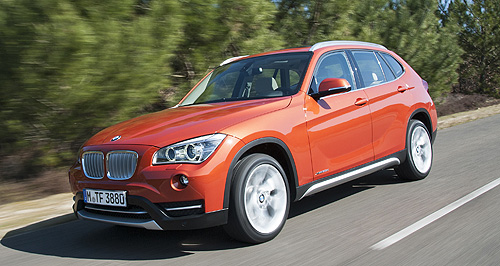Future models - BMW - X1BMW on countdown to X1 faceliftX factor: Documents seen by GoAuto reveal the updated X1’s engine line-up of four-cylinder units, three months ahead of its official Australian launch. Facelifted X1 SUV to open with frugal diesel plus BMW’s new turbo-petrol engines27 Jul 2012 BMW’S X1 compact SUV looks set for a range reshuffle – and revised pricing as a result – when the facelifted model arrives in Australia in October or November. GoAuto has uncovered the revised X1’s new line-up of efficient four-cylinder engines, consisting of two petrol and two diesel units, available with eight-speed automatic transmissions. Rear-drive sDrive variants will get a new 105kW/320Nm diesel 18d entry point to replace the 110kW/200Nm petrol 18i, and will be joined by the 135kW/270Nm turbo-petrol sDrive20i, which usurps the 130kW/350Nm 20d. On all-wheel-drive xDrive variants will be a new 135kW/380Nm 20d, producing 5kW and 50Nm more than before, and a higher-tuned 180kW/350Nm version of the petrol engine to create a new 28i range-topper that will replace the outgoing 150kW/400Nm 23d. The 28i will also serve as a more powerful yet more efficient successor to the original X1’s 160kW/277Nm 3.0-litre six-cylinder 25i variant, which was discontinued earlier this year due to slow sales. On average, performance and fuel consumption will be improved despite the reduction in diesel engines, due to the adoption of BMW’s N20 petrol powerplant in the 20i and 28i, which combines turbocharging, direct injection and precise valve control to extract high power and torque outputs from less fuel. The sDrive18d will reach 100km/h in 9.6 seconds as a manual or 9.9s with the automatic, respectively one-tenth and five-tenths quicker than the old 18i while consuming just 4.9 litres per 100 kilometres (manual) or 5.0L/100km (auto) compared with 8.2L/100km and 8.4L/100km. The only variant not to get a badge change will be the xDrive20d, which will take 8.1s to reach 100km/h as a manual or automatic, as much as half a second quicker than before while consuming up to 0.8L/100km less (auto vs auto). Top performer, with the biggest performance gain, will be the petrol 28i, which will take 6.1s to hit 100km/h as a manual, 1.3s quicker than the auto-only 23d and 1.8s better than the far thirstier 25i. The facelifted X1 was first unveiled at the New York motor show in April, marking the model’s debut in the North American market, where it had been absent for two years compared with other regions. Although the new engine and transmission combinations headline the update, external changes include a sleeker new front bumper and more upmarket grille plus redesigned headlight internals including optional Xenon units with LED “corona ring” effect. The door mirrors gain indicator lights and the X1’s side sills have been reshaped to match the bumper, while the overall styling effect is less rugged, with larger areas of body-coloured surfaces. Matt silver exterior flourishes are replicated inside, where the mildly restyled cockpit features a better-integrated centre console. Like other new BMW models introduced recently such as the 1 Series and 3 Series, the new X1 will adopt the ‘Lines’ customisation scheme, including the xLine that is said to accentuate the car’s versatile, outdoorsy image, and Sport Line, which focuses on agility and dynamics. The facelift will also introduce BMW’s Eco Pro mode for the Driving Experience control, which modifies various onboard systems to cut fuel use and coaches the driver to drive efficiently. Infotainment will also receive a boost, with BMW’s ConnectedDrive system providing in-car internet, downloadable apps and social networking on the move where specified. BMW recently reached 300,000 global sales with the X1 since its introduction in late 2009. As the current model enters runout in Australia, X1 sales to the end of June are 35.3 per cent down at 747 units, but it still holds a respectable 51.7 per cent share of the segment for small SUVs over $40,000. However, its share has been eroded by the new Audi Q3, which has already taken a 28.8 per cent slice of the segment with 417 sales since it was launched in Australia at the end of March. BMW’s Mini Countryman took the remaining 19.5 per cent, with 282 units sold, a rise of 35.6 per cent on the same period last year.  Read moreAll future models Alfa Romeo Alfa Romeo Abarth Abarth Audi Audi Aston Martin Aston Martin BMW BMW Bentley Bentley Chrysler Chrysler Chevrolet Chevrolet Dodge Dodge Citroen Citroen Ferrari Ferrari DS DS Ford Ford Fiat Fiat FPV FPV Foton Foton Haval Haval Great Wall Great Wall Honda Honda Holden Holden Hyundai Hyundai HSV HSV Isuzu Isuzu Infiniti Infiniti Jeep Jeep Jaguar Jaguar Lamborghini Lamborghini Kia Kia Lexus Lexus Land Rover Land Rover Mazda Mazda Maserati Maserati Mercedes-Benz Mercedes-Benz McLaren McLaren Mini Mini Nissan Nissan Mitsubishi Mitsubishi Peugeot Peugeot Opel Opel Proton Proton Porsche Porsche Renault Renault Ram Ram Saab Saab Rolls-Royce Rolls-Royce Smart Smart Skoda Skoda Subaru Subaru SsangYong SsangYong Tesla Tesla Suzuki Suzuki Toyota Toyota Volvo VolvoX1 pricing
Motor industry news |
Click to shareBMW modelsResearch BMW All future models Alfa Romeo Alfa Romeo Abarth Abarth Audi Audi Aston Martin Aston Martin BMW BMW Bentley Bentley Chrysler Chrysler Chevrolet Chevrolet Dodge Dodge Citroen Citroen Ferrari Ferrari DS DS Ford Ford Fiat Fiat FPV FPV Foton Foton Haval Haval Great Wall Great Wall Honda Honda Holden Holden Hyundai Hyundai HSV HSV Isuzu Isuzu Infiniti Infiniti Jeep Jeep Jaguar Jaguar Lamborghini Lamborghini Kia Kia Lexus Lexus Land Rover Land Rover Mazda Mazda Maserati Maserati Mercedes-Benz Mercedes-Benz McLaren McLaren Mini Mini Nissan Nissan Mitsubishi Mitsubishi Peugeot Peugeot Opel Opel Proton Proton Porsche Porsche Renault Renault Ram Ram Saab Saab Rolls-Royce Rolls-Royce Smart Smart Skoda Skoda Subaru Subaru SsangYong SsangYong Tesla Tesla Suzuki Suzuki Toyota Toyota Volvo VolvoX1 pricing
Motor industry news |





























Facebook Twitter Instagram